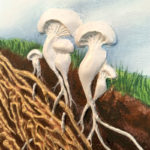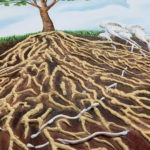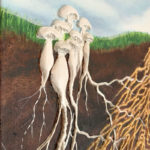This painting expresses a small snippet of a visual of the vast and incredible interconnected root system of the forest with the mycelial network. I had fun sculpting and molding mushrooms (I’m so punny) using acrylic modelling paste. My dimensional fungal roots weave into those of the tree.
Millions of species of fungi and bacteria swap nutrients between soil and the roots of trees, forming a vast, interconnected community of organisms throughout the woods supporting each other. Scientists have mapped this “wood wide web” on a global scale, using a database of over 28,000 tree species in more than 70 countries. So, if I were representing this with accuracy rather than for the joy of art, there would be a ton more varieties of fungi and fungus roots.
If we could become a community of shrooms, we could fix things quickly and create a happier place to live.
Wood Wide Web baby…
The Wood Wide Web is a fairly new and surprising discovery. Research has shown that beneath every forest and wood there is a complex underground web of roots, fungi and bacteria connecting trees and plants to one another. This subterranean social network, nearly 500 million years old, is now known as the “wood wide web”
Check out this link. Article isn’t too long.
Science.org article on the Wood Wide Web
Definition of Mycelium
Mycelium (plural mycelia) is a root-like structure of a fungus consisting of a mass of branching, thread-like hyphae. Fungal colonies composed of mycelium are found in and on soil and many other substrates.
What can we do?
Go for a walk in the forest. That woodsy smell is predominantly fungi. Take it in. Meditate on the cool world beneath your feet. It’s a community of life that cares for each other.
What you can do
Support Forests
Learn more about this fascinating science and support the science, and forests.
Make a Pledge!
[contact-form-7 id=”1700″ title=”Canada Pledge_copy”]
Share your pledge and ask your friends to join you.







